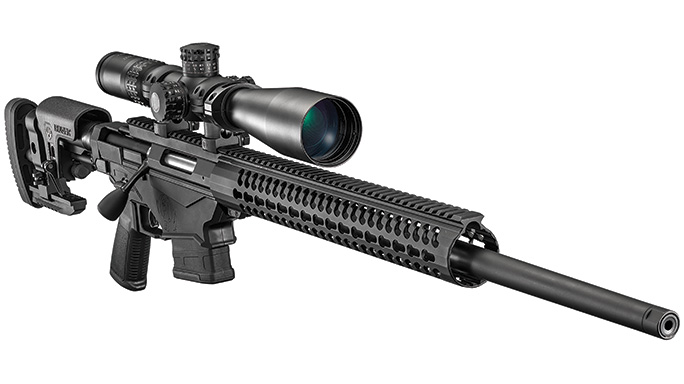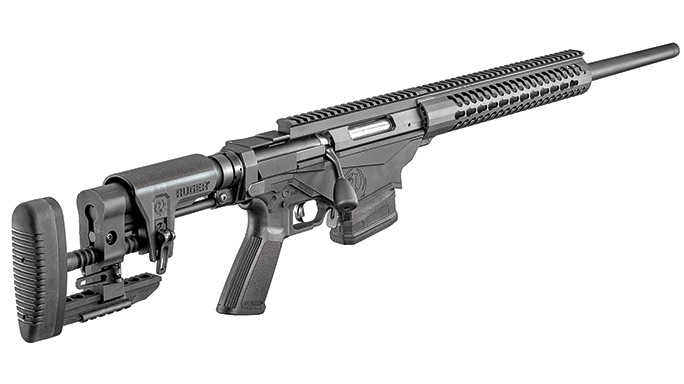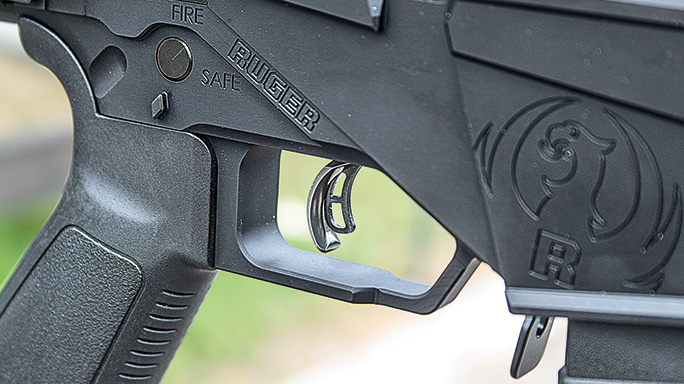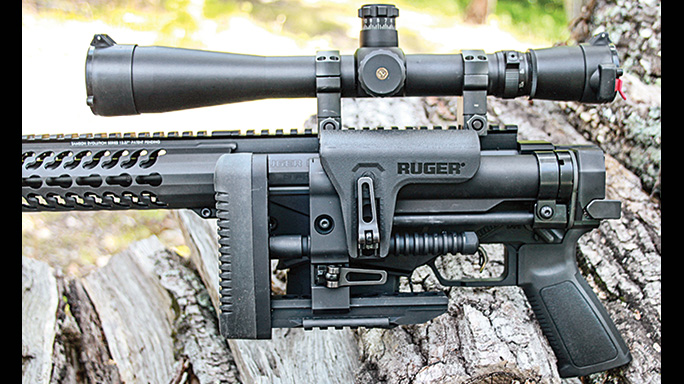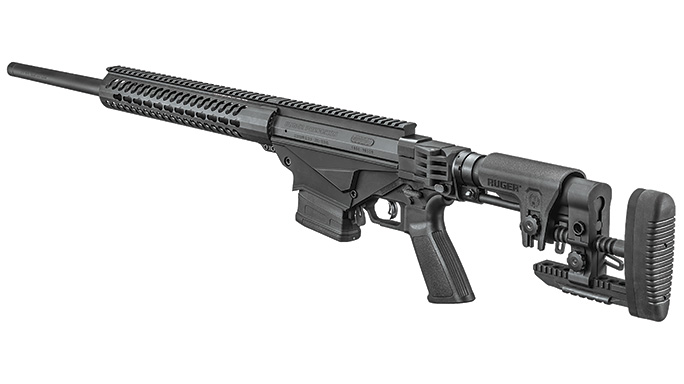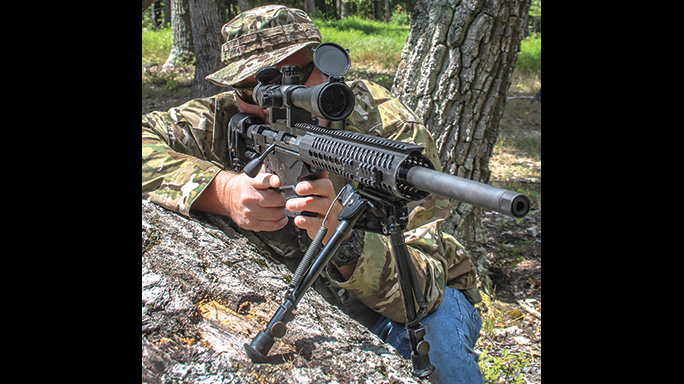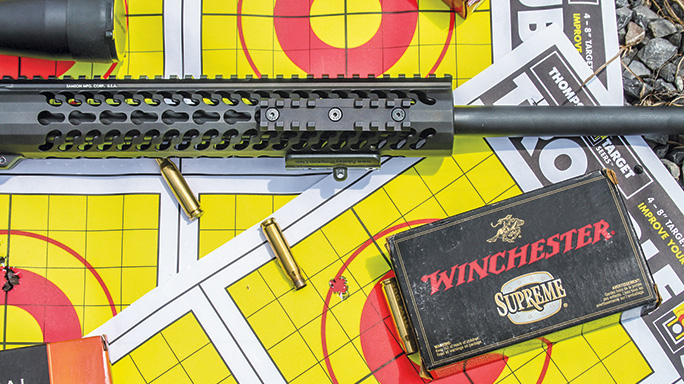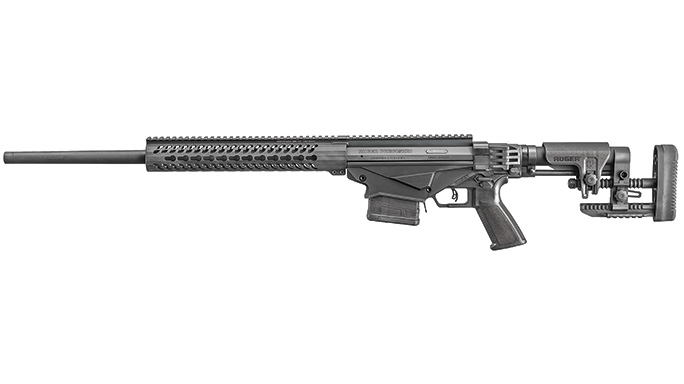Sturm, Ruger & Company is a well-known manufacturer in the U.S., making some of the best rifles and handguns for tactical missions, personal defense and competition. Now the company has gone a new direction by introducing the Ruger Precision Rifle, an affordable yet highly accurate bolt-action rifle designed for long-range engagements and utilizing a detachable magazine.
- RELATED STORY: Gun Test: Ruger’s Precision Rifle Is on the Mark
Any police department or law enforcement agency considering a precision rifle should consider the Ruger Precision Rifle. It is available from the factory in 7.62mm NATO, 6.5 Creedmoor and .243 Winchester. It comes with many notable features, including a fully adjustable, folding stock, a threaded muzzle, a full-length Picatinny top rail and Ruger’s Marksman Adjustable trigger, with a pull weight that can be adjusted between 2.25 and 5 pounds. One thing that distinguishes the Precision Rifle is its ability to accept multiple types of detachable magazines, including those from DPMS, Knight’s Armament, Magpul and Accuracy International. Two 10-round Magpul PMAGs come with each Ruger Precision Rifle.
And you’ll immediately notice its price. Its MSRP is $1,399. Of course, the Ruger Precision Rifle’s affordability may create some prejudices in shooters who judge a weapon’s value by its price. Many individuals, not to mention industry competitors, will want you to believe that the moderately priced Precision Rifle must somehow be deficient when compared to rifles costing two to three times more. All I can urge is for every individual or department to evaluate this weapon. The Ruger Precision Rifle takes a backseat to no other rifle in its class in terms of precision, repeatable accuracy, ergonomics, reliability, firepower and safety.
Advertisement — Continue Reading Below
American-Made
I was lucky enough to get my hands on a Ruger Precision Rifle chambered in 7.62mm NATO. Aside from the 6.5 Creedmoor and .243 Winchester variants, many are already salivating at the thought of a .300 Win Mag or even a .338 Lapua Mag version appearing down the road.
The Precision Rifle is built around a modified Ruger American bolt action. The 7.62mm version, with its 20-inch barrel, has an overall length of 30.6 inches with the stock folded and 41.75 inches with the stock fully extended. The medium-profile barrel is cold-hammer forged from 4140 chrome-moly steel with 5R rifling in a 1-in-10-inch twist rate. This twist rate is great for a wide range of 7.62mm loads, from 147 to 175 grains. The muzzle has 5/8×24 threading for suppressor use, and Ruger ships the rifle with a thread protector.
Advertisement — Continue Reading Below
The AR influence is hard to escape for any rifle nowadays—even bolt actions—and the rifle features upper and lower receivers. The upper receiver and bolt are CNC-machined from pre-hardened 4140 chrome-moly steel. The upper has an integral 20-MOA Picatinny rail secured with four #8-40 screws for increased long-range capabilities. The three-lug, full-diameter bolt has a 70-degree throw along with dual cocking cams. The bottom bolt lug is ideal for stripping rounds from the detachable magazines. Ruger also decided to go with an enlarged bolt handle for positive bolt manipulations. If a user so chooses, a different bolt handle can be installed. A bolt disassembly tool is stored in the bolt shroud for easy striker channel cleaning.
The barrel can be changed out using techniques and tools common with AR-15 rifles. Surrounding the barrel is a free-floating Samson Evolution KeyMod AR handguard. As with the buttstock, most AR-style forends can be installed if a user is so inclined. The same can be said of the AR-style pistol grip and fire selector switch. The Precision Rifle’s magazine well, which allows it to feed and run reliably with several magazine types, is machined from aerospace-grade 7075-T6 aluminum that has been Type III hardcoat anodized for maximum durability.
Ruger has chosen a different path from typical bedded stocks or even the chassis systems that seem to be gaining in popularity. The Precision Rifle utilizes a linear in-line recoil path to maximize its accuracy potential by directing unwanted movement and vibration straight back into the buttstock. This minimizes the impact on barrel harmonics when the rifle is fired; the key here is consistency during the firing impulse. The stock is threaded into the rear of the receiver, in effect becoming a part of it. Any AR-style stock can be used over the buffer-tube-like projection if a user feels the MSR stock is not to their liking for some reason.
Advertisement — Continue Reading Below
Unloaded, the rifle weighs in at 9.7 pounds. The rifle’s relatively light weight, compared to other precision rifles on the market, makes it easy to carry and gives it above average handling characteristics for a tactical bolt-action rifle. Many tactical rifles, while accurate, resemble boat anchors when it comes to handling due to their weight and stock configuration—but not the Ruger Precision Rifle.
Some may wonder what the purpose or niche is for the Ruger Precision Rifle. Why not just use a tuned semi-automatic AR in lieu of this bolt-action rifle? The answer lies with an individual or department’s preferences for a bolt action. This could be based on cost, public perceptions or a myriad of other reasons. Ruger has designed a rifle that is rock solid with characteristics making it conducive to accurate shooting from a variety of positions.
The rifle is not exclusively designed for shooting from prone or benchrest positions. The forend handles bipods or sandbags with aplomb. The stock allows for off-hand and other types of supported fire if needed. Think field-expedient positions like shooting from the trunk or hood of a squad car. The adjustable Ruger MSR buttstock offers a comfortable, repeatable cheekweld. This combines with an AR-style pistol grip that makes it much easier to pull the Ruger Marksman trigger smoothly to the rear every time.
Advertisement — Continue Reading Below
Of course, tactical rifles must be accurate. To that end, I mounted a Leupold 3.5-10x50mm Mark 4 scope with a mil-dot reticle onto the Precision Rifle via Leupold rings. This scope offers Leupold’s typical reliability, clarity and image quality with a magnification range perfect for a 7.62mm precision rifle. Aside from this scope, I also used a Champion tripod front rest and sandbags to wring out the rifle’s accuracy at the range.
To test the rifle, I used various loads from Black Hills, Federal, Winchester and Hornady. The Precision Rifle’s 20-inch barrel produced velocity readings in the low 2,600-fps range with the 168-grain loads. In essence, the 20-inch barrel maximizes portability and handling while maintaining 7.62mm ballistics and terminal performance. As can be expected with quality ammunition, velocity figures measured by an RCBS chronograph deviated very little from round to round. The Precision Rifle produced 1-MOA or better groups with several different ammunition brands—an important logistic consideration.
After the 100-yard evaluation, I easily smacked steel targets out to 310 yards using field-expedient rests at the Echo Valley Training Center. While by no means rivaling a semi-automatic for pure firepower, the detachable magazines were handy for reloading the Precision Rifle. The action was slick and smooth straight from the box.
Advertisement — Continue Reading Below
Making Its Mark
Even though it’s a bolt action imminently qualified to serve a precise tactical weapon, the Ruger Precision Rifle should not be pigeonholed into solely a sniper rifle role. There many jurisdictions that will appreciate its non-assault rifle persona while maintaining its high capacity. Think of it as a lightweight patrol rifle with 10+1 rounds on tap.
- RELATED VIDEO: Ruger’s Brand New Precision Rifle In 6.5 Creedmoor
The Ruger Precision Rifle performed better than some rifles I’ve tested in this format that cost significantly more. And once again I urge you, whether civilian or LEO, not to fall into the trap of thinking that dollars equate into proficiency. Yes, equipment is a huge part of the skills equation when it comes to marksmanship, but that doesn’t make up for training and practice. The Ruger Precision Rifle is not at all a compromise in terms of performance, though a user will benefit from selecting it by having funds left in the budget for optics, ammunition and training.
Advertisement — Continue Reading Below
For more information, visit ruger.com.
